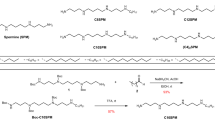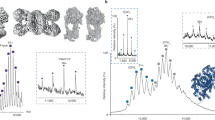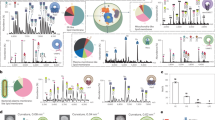Abstract
Recent applications of mass spectrometry (MS) to study membrane protein complexes are yielding valuable insights into the binding of lipids and their structural and functional roles. To date, most native MS experiments with membrane proteins are based on detergent solubilization. Many insights into the structure and function of membrane proteins have been obtained using detergents; however, these can promote local lipid rearrangement and can cause fluctuations in the oligomeric state of protein complexes. To overcome these problems, we developed a method that does not use detergents or other chemicals. Here we report a detailed protocol that enables direct ejection of protein complexes from membranes for analysis by native MS. Briefly, lipid vesicles are prepared directly from membranes of different sources and subjected to sonication pulses. The resulting destabilized vesicles are concentrated, introduced into a mass spectrometer and ionized. The mass of the observed protein complexes is determined and this information, in conjunction with ‘omics’-based strategies, is used to determine subunit stoichiometry as well as cofactor and lipid binding. Within this protocol, we expand the applications of the method to include peripheral membrane proteins of the S-layer and amyloid protein export machineries overexpressed in membranes from which the most abundant components have been removed. The described experimental procedure takes approximately 3 d from preparation to MS. The time required for data analysis depends on the complexity of the protein assemblies embedded in the membrane under investigation.
This is a preview of subscription content, access via your institution
Access options
Access Nature and 54 other Nature Portfolio journals
Get Nature+, our best-value online-access subscription
$29.99 / 30 days
cancel any time
Subscribe to this journal
Receive 12 print issues and online access
$259.00 per year
only $21.58 per issue
Buy this article
- Purchase on Springer Link
- Instant access to full article PDF
Prices may be subject to local taxes which are calculated during checkout





Similar content being viewed by others
Data availability
Raw data presented in this paper are either deposited in https://doi.org/10.6084/m9.figshare.11376015 or available on request.
Code availability
No code has been written for this manuscript. The software needed is stated and referenced in the text.
References
Chorev, D. S. et al. Protein assemblies ejected directly from native membranes yield complexes for mass spectrometry. Science 362, 829–834 (2018).
Zeev-Ben-Mordehai, T. et al. Two distinct trimeric conformations of natively membrane-anchored full-length herpes simplex virus 1 glycoprotein B. Proc. Natl Acad. Sci. USA 113, 4176–4181 (2016).
Watson, H. Biological membranes. Essays Biochem. 59, 43–69 (2015).
Gu, J. et al. Cryo-EM structure of the mammalian ATP synthase tetramer bound with inhibitory protein IF1. Science 364, 1068–1075 (2019).
Blum, T. B., Hahn, A., Meier, T., Davies, K. M. & Kuhlbrandt, W. Dimers of mitochondrial ATP synthase induce membrane curvature and self-assemble into rows. Proc. Natl Acad. Sci. USA 116, 4250–4255 (2019).
Maki-Yonekura, S. et al. Hexameric and pentameric complexes of the ExbBD energizer in the Ton system. eLife 7, e35419 (2018).
Hellwig, N. et al. Native mass spectrometry goes more native: investigation of membrane protein complexes directly from SMALPs. Chem. Commun. (Camb.) 54, 13702–13705 (2018).
Keener, J. E. et al. Chemical additives enable native mass spectrometry measurement of membrane protein oligomeric state within intact nanodiscs. J. Am. Chem. Soc. 141, 1054–1061 (2019).
Celia, H. et al. Cryo-EM structure of the bacterial Ton motor subcomplex ExbB–ExbD provides information on structure and stoichiometry. Commun. Biol. 2, 358 (2019).
Postis, V. et al. The use of SMALPs as a novel membrane protein scaffold for structure study by negative stain electron microscopy. Biochim. Biophys. Acta 1848, 496–501 (2015).
Gupta, K. et al. The role of interfacial lipids in stabilizing membrane protein oligomers. Nature 541, 421–424 (2017).
Ambrose, S. et al. Native desorption electrospray ionization liberates soluble and membrane protein complexes from surfaces. Angew. Chem. Int. Ed. Engl. 56, 14463–14468 (2017).
van de Waterbeemd, M. et al. High-fidelity mass analysis unveils heterogeneity in intact ribosomal particles. Nat. Methods 14, 283–286 (2017).
Gault, J. et al. High-resolution mass spectrometry of small molecules bound to membrane proteins. Nat. Methods 13, 333–336 (2016).
Barrera, N. P., Di Bartolo, N., Booth, P. J. & Robinson, C. V. Micelles protect membrane complexes from solution to vacuum. Science 321, 243–246 (2008).
Yen, H. Y. et al. PtdIns(4,5)P2 stabilizes active states of GPCRs and enhances selectivity of G-protein coupling. Nature 559, 423–427 (2018).
Laganowsky, A. et al. Membrane proteins bind lipids selectively to modulate their structure and function. Nature 510, 172–175 (2014).
Habeck, M., Kapri-Pardes, E., Sharon, M. & Karlish, S. J. Specific phospholipid binding to Na,K-ATPase at two distinct sites. Proc. Natl Acad. Sci. USA 114, 2904–2909 (2017).
Landreh, M., Costeira-Paulo, J., Gault, J., Marklund, E. G. & Robinson, C. V. Effects of detergent micelles on lipid binding to proteins in electrospray ionization mass spectrometry. Anal. Chem. 89, 7425–7430 (2017).
Myers, J. B. et al. Structure of native lens connexin 46/50 intercellular channels by cryo-EM. Nature 564, 372–377 (2018).
Zhao, D. Y. et al. Cryo-EM structure of the native rhodopsin dimer in nanodiscs. J. Biol. Chem. 294, 14215–14230 (2019).
van Meer, G., Voelker, D. R. & Feigenson, G. W. Membrane lipids: where they are and how they behave. Nat. Rev. Mol. Cell Biol. 9, 112–124 (2008).
Parmar, M. et al. Using a SMALP platform to determine a sub-nm single particle cryo-EM membrane protein structure. Biochim. Biophys. Acta Biomembr. 1860, 378–383 (2018).
Zeev-Ben-Mordehai, T., Vasishtan, D., Siebert, C. A., Whittle, C. & Grunewald, K. Extracellular vesicles: a platform for the structure determination of membrane proteins by cryo-EM. Structure 22, 1687–1692 (2014).
Akbarzadeh, A. et al. Liposome: classification, preparation, and applications. Nanoscale Res. Lett. 8, 102 (2013).
Carlson, M. L. et al. Profiling the E. coli membrane interactome captured in peptidisc libraries. eLife 8, e46615 (2019).
Shevchenko, A., Tomas, H., Havlis, J., Olsen, J. V. & Mann, M. In-gel digestion for mass spectrometric characterization of proteins and proteomes. Nat. Protoc. 1, 2856–2860 (2006).
Bechara, C. et al. A subset of annular lipids is linked to the flippase activity of an ABC transporter. Nat. Chem. 7, 255–262 (2015).
Bird, S. S., Marur, V. R., Sniatynski, M. J., Greenberg, H. K. & Kristal, B. S. Lipidomics profiling by high-resolution LC–MS and high-energy collisional dissociation fragmentation: focus on characterization of mitochondrial cardiolipins and monolysocardiolipins. Anal. Chem. 83, 940–949 (2011).
Meuskens, I., Michalik, M., Chauhan, N., Linke, D. & Leo, J. C. A new strain collection for improved expression of outer membrane proteins. Front. Cell. Infect. Microbiol. 7, 464 (2017).
Evinger, M. & Agabian, N. Envelope-associated nucleoid from Caulobacter crescentus stalked and swarmer cells. J. Bacteriol. 132, 294–301 (1977).
Ireland, M. M., Karty, J. A., Quardokus, E. M., Reilly, J. P. & Brun, Y. V. Proteomic analysis of the Caulobacter crescentus stalk indicates competence for nutrient uptake. Mol. Microbiol. 45, 1029–1041 (2002).
Urbani, A. et al. Purified F-ATP synthase forms a Ca2+-dependent high-conductance channel matching the mitochondrial permeability transition pore. Nat. Commun. 10, 4341 (2019).
Marty, M. T. et al. Bayesian deconvolution of mass and ion mobility spectra: from binary interactions to polydisperse ensembles. Anal. Chem. 87, 4370–4376 (2015).
Taverner, T. et al. Subunit architecture of intact protein complexes from mass spectrometry and homology modeling. Acc. Chem. Res. 41, 617–627 (2008).
Baker, L. A. et al. Magic-angle-spinning solid-state NMR of membrane proteins. Methods Enzymol. 557, 307–328 (2015).
Maeda, S. et al. Two-dimensional crystallization of intact F-ATP synthase isolated from bovine heart mitochondria. Acta Crystallogr. Sect. F. Struct. Biol. Cryst. Commun. 69, 1368–1370 (2013).
Hernandez, H. & Robinson, C. V. Determining the stoichiometry and interactions of macromolecular assemblies from mass spectrometry. Nat. Protoc. 2, 715–726 (2007).
Laganowsky, A., Reading, E., Hopper, J. T. & Robinson, C. V. Mass spectrometry of intact membrane protein complexes. Nat. Protoc. 8, 639–651 (2013).
Gupta, K. et al. Identifying key membrane protein lipid interactions using mass spectrometry. Nat. Protoc. 13, 1106–1120 (2018).
Reid, D. J. et al. MetaUniDec: high-throughput deconvolution of native mass spectra. J. Am. Soc. Mass Spectrom. 30, 118–127 (2019).
Cleary, S. P. & Prell, J. S. Liberating native mass spectrometry from dependence on volatile salt buffers by use of Gabor transform. Chemphyschem 20, 519–523 (2019).
Rouse, S. L. et al. A new class of hybrid secretion system is employed in Pseudomonas amyloid biogenesis. Nat. Commun. 8, 263 (2017).
Bharat, T. A. M. et al. Structure of the hexagonal surface layer on Caulobacter crescentus cells. Nat. Microbiol. 2, 17059 (2017).
Hopper, J. T. et al. Detergent-free mass spectrometry of membrane protein complexes. Nat. Methods 10, 1206–1208 (2013).
Bobeica, S. C. et al. Insights into AMS/PCAT transporters from biochemical and structural characterization of a double glycine motif protease. eLife 8, e42305 (2019).
Acknowledgements
The authors thank all C.V.R. group members for helpful discussions, L. Zhou for her help in photographing the capillaries, S. Chen for her help in photographing the experimental setup, R. Dhaliwal and E. Johnson from the Oxford Dunn School EM facility for scanning EM imaging, T. Zeev-Ben-Mordehai for her technical assistance with MPEEVs and H. D. Bernstein for providing the plasmid pJH114 for expressing the Bam complex. D.S.C., H.T. and C.V.R. are grateful for the support of an ERC grant (695511- ENABLE), and J.G., D.W. and C.V.R. for support by a Wellcome Trust Investigator Award (104633/Z/14/Z). J.R.B. and C.V.R. are supported by a Medical Research Council grant (MR/N020413/1). T.A.M.B. is supported by the Wellcome Trust and the Royal Society (grant no. 202231/Z/16/Z). A.v.K., T.A.M.B. and C.V.R. thank the Vallee Foundation for support. S.L.R. and S.J.M. are supported by a Wellcome Trust (Senior Investigator Award 100280). J.G. is a Junior Research Fellow at Queen’s College, University of Oxford. L.A.B. was supported by a Human Frontier Science Program Long Term Fellowship and a Canadian Institutes for Health Research Postdoctoral Fellowship. K.G. was supported by a Wellcome Trust Senior Research Fellowship (090895/Z/09/Z) and a core award (090532/Z/09/Z).
Author information
Authors and Affiliations
Contributions
D.S.C. performed the MS experiments. H.T. performed the MS experiments for S-layer proteins and membranes. J.G. optimized the Orbitrap UHMR platform for the transmission and detection of membrane proteins and to enable high-energy regimes. J.R.B. purified and analyzed the recombinant Bam complex. D.W. established and applied the lipidomics platform. S.L.R. and S.J.M. purified Fap proteins and membranes, and modelled the Fap complexes. A.v.K. and T.A.M.B. purified S-layer proteins and membranes, and performed cryo-EM of cell stalks. L.A.B. and K.G. performed the cryo-EM for inner membrane tubes. D.S.C. and C.V.R. supervised the research and wrote the manuscript with contributions from all authors.
Corresponding author
Ethics declarations
Competing interests
The authors declare no competing interests.
Additional information
Publisher’s note Springer Nature remains neutral with regard to jurisdictional claims in published maps and institutional affiliations.
Related link
Key reference using this protocol
Chorev, D. S. et al. Science 362, 829–834 (2018): https://doi.org/10.1126/science.aau0976
Integrated supplementary information
Supplementary Fig. 1 Large protein complexes containing gB eject in high-energy conditions.
(a) SDS-gel of MPEEV containing the protein gB. (b) Native gel of the vesicles shows only one protein complex at ~480 kDa. (c) The vesicles are first analysed at 400 V (source fragmentation 300 V, HCD 100 V). As the energy is increased, more proteins are released from the vesicle, at 500 V (additional 100 V in the HCD cell), monomers of gB start appearing, whereas at 600 V (additional 200 V in the HCD cell), a 465 kD complex appears. 2 biological repeats and 4 overall injections were performed.
Supplementary Fig. 2 BN and SDS–PAGE of samples.
(a) BN-PAGE of E. coli membranes, without major outer membrane complexes, overexpressing the fap operon with and without DDM indicates the existence of two 180–200 kDa membrane protein complexes containing Fap proteins in the presence of DDM. (b) SDS–PAGE of C. crescentus membrane stalks containing the S-layer or extracted S-layer protein RsaA shows degradation products following low pH extraction.
Supplementary Fig. 3 Low m/z region of protein from the fap operon purified in detergent shows different FapD species dissociating from the FapF3–FapD complex.
High energy disruption of the FapF3–FapD complexes at 400 V induces their dissociation and reveals the co-existence of three different FapD species—a correctly processed FapD at 23,313 Da, an incompletely processed FapD’ at 24,596 Da and a self-processed FapD’’ with a mass of 22,488 Da. Spectrum is a representative from 2 biological repeats.
Supplementary Fig. 4 Mass spectrum of low-pH-extracted RsaA.
Mass spectrum of solution extracted RsaA shows the presence of RsaA monomer and dimer with only a very low population of trimer. Inset (i) shows the organization of the S-layer associated with LPS and tethered to the outer membrane. The spectrum was acquired at a capillary voltage of 1.4 kV, capillary temperature of 50 °C, with source fragmentation set to 100 V, desolvation voltage set to 0 V and HCD energy at 0 V.
Supplementary information
Supplementary Information
Supplementary Figs. 1–4 and Supplementary Table 1.
Rights and permissions
About this article
Cite this article
Chorev, D.S., Tang, H., Rouse, S.L. et al. The use of sonicated lipid vesicles for mass spectrometry of membrane protein complexes. Nat Protoc 15, 1690–1706 (2020). https://doi.org/10.1038/s41596-020-0303-y
Received:
Accepted:
Published:
Issue Date:
DOI: https://doi.org/10.1038/s41596-020-0303-y
This article is cited by
Comments
By submitting a comment you agree to abide by our Terms and Community Guidelines. If you find something abusive or that does not comply with our terms or guidelines please flag it as inappropriate.



